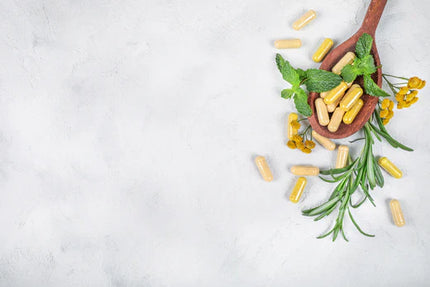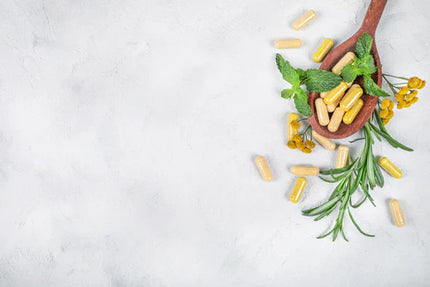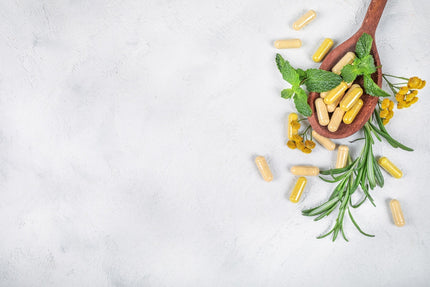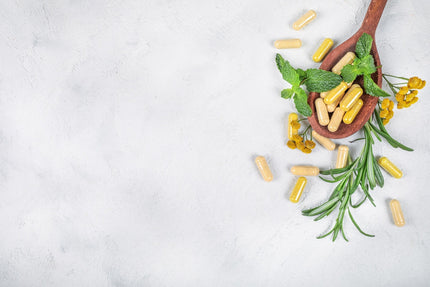Herbs That May Assist
Curcumin
Turmeric longa, root
BosPure ® Boswellia
Boswellia serrata, dry gum oleoresin
Rhuleave-K™
Actions
- Anti-inflammatory
- Analgesic and antinociceptive
Clinical Applications
- ·Acute pain
Clinical Overview
Inflammatory pain is a prominent health burden that impacts the lives of countless individuals. To help manage acute pain symptoms, Rhuleave-K™ is a clinically proven blend of curcumin derived from Curcuma longa and Boswellia serrata (boswellia) within black sesame oil that offers effective analgesia. Supported by human studies, this combination noticeably reduces muscular pain within 63 minutes, [1] and offers a similar time-to-effect as paracetamol. [2] Rhuleave-K™ features innovative SPEEDTECH™ technology, which combines particle micronisation within a phospholipid-rich [*]sesame oil delivery system [3] to enhance curcumin and boswellia absorption. [4] As such, this formulation can provide a fast-acting natural solution for inflammatory pain.
Background Information
Understanding the Inflammatory Process
Inflammation is an adaptive response caused by harmful stimuli, such as tissue damage in the body. [5] The process of inflammation is mediated in four stages facilitated by:
- Cell receptors that induce intracellular inflammatory signalling (e.g. toll-like receptors [TLRs], NOD-like receptor pyrin domain containing 3 [NLRP3]). [6]
- Messenger proteins that relay these signals into cell nuclei (e.g. peroxisome proliferator-activated receptor gamma [PPAR-γ] and IkappaB kinase [IKK]). [7]
- Inflammatory transcription factors that enter nuclei and interact with deoxyribonucleic acid (DNA), such as nuclear factor kappa B (NFκB), [8] to stimulate the transcription of:
-
Effector mediators that are released into tissue, including [9]:
- Pro-inflammatory cytokines (e.g. interleukin 1, 1β, and 6 [IL-1], IL-1β and IL-6] and tumour necrosis factor alpha [TNF-α]); and,
- Pro-inflammatory enzymes (e.g. cyclooxygenases [COX] and lipoxygenases [LOX]), which promote arachidonic acid inflammatory pathways (e.g. prostaglandin, thromboxane and leukotriene activity).
These inflammatory mediators act upon immune and vascular cells at the site of tissue damage, which promote the cardinal signs of inflammation in response to injury: heat, swelling, redness and pain. [10]
A Natural Alternative for Acute Pain
To alleviate the symptoms of acute inflammation, paracetamol and non-steroidal anti-inflammatories (NSAIDs) are among the most widely used analgesics globally. [11] However, for many individuals who take these over the counter (OTC) medicines, complete relief may be difficult to achieve with a single agent. [12] Moreover, single doses above maximum recommendations (i.e. >400 mg of ibuprofen [NSAID] and >1,000 mg of paracetamol) may result in higher risks of adverse events [†]. [13] Providing a natural option, curcumin and boswellia within Rhuleave-K™ has been shown to relieve musculoskeletal pain within 63 minutes. [14] Moreover, these analgesic herbs have been shown to achieve comparable outcomes to paracetamol [15] and NSAIDs. [16],[17] As such, this combination can offer individuals an effective alternative to OTC pain treatments.
Enhanced Herbal Efficacy with SPEEDTECH™
Unique to the manufacture of Rhuleave-K™, proprietary SPEEDTECH™ technology [‡] enhances curcumin and boswellia absorption, helping to overcome the low bioavailability of these extracts. [18],[19] By combining natural ingredients through a high-speed milling process, SPEEDTECH™ micronises botanical particles within a phospholipid-rich base of sesame oil [20] to create a highly bioavailable dispersion of active compounds. For this reason, specialised SPEEDTECH™ technology can maximise the anti-inflammatory benefits of Rhuleave-K™ for greater clinical effects (Figure 1). [21],[22],[23],[24]

Figure 1: Innovative SPEEDTECH™ technology designed to enhance curcumin and boswellia absorption.
Actions
Anti-inflammatory
Boswellia and curcumin possess therapeutic actions that target several stages of inflammation. For example, boswellia inhibits intermediate messenger molecule IKK in vitro, thereby limiting its effect on promoting NFκB activation. [25] Subsequently, boswellia downregulates pro-inflammatory cytokines, including TNF-α, IL-1 and IL-6, which may help to mitigate acute inflammatory pain. [26] Additionally, boswellia blocks the activity of the enzyme, 5-LOX, [27],[28] thereby reducing leukotriene B4 synthesis in vitro, which plays a key role in attracting pro-inflammatory cells into tissues (e.g. neutrophils and eosinophils). [29] In animals, these properties have been shown to achieve greater anti-inflammatory effects in combination with COX inhibitors, highlighting the adjunctive treatment benefits of boswellia. [30]
Curcumin also moderates the inflammatory response. [31] Specifically, curcumin binds to TLRs and PPAR-γ, which inhibit NFκB and other transcriptional signalling molecules that promote inflammatory pathways (e.g. Janus kinase [JAK] and signal transducer and activator of transcription [STAT]). [32] Through these mechanisms, curcumin has been observed to lower cytokine levels, such as TNF-α, IL-1, IL-1β, IL-6 and IL-8. [33],[34] Moreover, through downregulating transcriptional mediators, curcumin reduces the expression of COX-2 and 5-LOX in vitro, which promote the release pro-inflammatory prostaglandins and leukotrienes. [35],[36] This dual action of curcumin on both these enzymes may provide potential advantages over NSAIDs that target COX-2 pathways alone. [37] Interestingly, human studies have shown curcumin-containing extracts to reduce COX-2 levels as effectively as to NSAIDs, [38] further supporting the benefits of curcumin compared to OTC pain relief.
Analgesic and Antinociceptive
Through targeting sensory pain receptors (nociceptors), analgesic agents can help to reduce pain perception. This in turn can help minimise pain sensitivity. [39],[40] Curcumin has been shown to reduce nociception via transient receptor potential vanilloid type 1 (TRPV1) and transient receptor potential ankyrin 1 (TRPA1), which are linked to heightened pain sensitivity. [41],[42] In addition, curcumin also stimulates adenosine triphosphate (ATP)-sensitive potassium channels that block nociceptor activation, which further dampens pain transmission. [43] Further to this, evidence indicates that curcumin can activate alpha 7 nicotinic acetylcholine receptors (α7-nACh), also associated with reducing nociceptive pain. [44] Demonstrating these effects, curcumin has been shown to limit pain sensitivity following injury in animals, [45] supporting its analgesic properties.
Clinical Applications
Acute Pain
Human clinical data supports the efficacy of Rhuleave-K™, which is comparable to a single dose of acetaminophen (paracetamol). This was demonstrated in a randomised open-label study conducted in 88 healthy subjects (mean age 42 ± 12 years) with grade 1 musculoskeletal strain [§].[46] Individuals received 1,000 mg/d Rhuleave K (equivalent to 266 mg/d curcumin and 1,000 mg/d boswellia extract; n=44) with breakfast or 1,000 mg of acetaminophen (n=44) and were monitored over six hours daily for seven days. Outcomes of the study revealed Rhuleave-K™ offered equal benefit to acetaminophen (p<0.001), achieving noticeable pain relief within 2.5 hours (Figure 2). After six hours, Rhuleave-K™ reduced total pain by 53.1% versus 55.4% in the pharmaceutical group, and lowered pain intensity by 37.7% comparable to acetaminophen (38.6%). Further, natural treatment improved pain quality and intensity after seven days by 71.8%, akin to OTC drug treatment (73.6%). [47]

Figure 2: Pain reduction with Rhuleave-K™ treatment was comparable to acetaminophen (p<0.001). [48]
The fast-acting benefits of Rhuleave-K™ were documented in 232 healthy individuals (mean age 36.4 years) with exercise-induced muscle pain. These patients received either Rhuleave-K™ (n=116) or placebo (n=116) and were monitored over six hours. [49] Results revealed a reduction of severe pain from greater than 74% to less than 3% in the head, neck, upper and lower limbs, torso and back (p<0.001). This demonstrated a relative >95% improvement in pain with Rhuleave-K™, while no significant relief occurred in the placebo group. Researchers also observed that perceived pain relief occurred around 63 minutes with active treatment. Further, complete pain relief in the head, neck, upper and lower limb, torso, and back was achieved in 3.1 hours. [50] As such, these studies support the anti-inflammatory effects of Rhuleave-K™.
Clinical evidence also supports the use of curcumin to minimise muscle pain following exercise. In a systematic review and meta-analysis of randomised-controlled clinical trials, researchers analysed data from 159 participants (aged 19.5 to 35.5) with muscle soreness. [51] These individuals received 150 mg/d to 6,000 mg/d of curcumin featuring enhanced bioavailability. Pooled statistics revealed that 150 mg/d to 180 mg/d of curcumin achieved a near significant effect in reducing muscle soreness (p<0.051). Further evaluation revealed this effect was significant in reducing pain in untrained individuals (p<0.001) following resistance exercise (p<0.001) after 72 and 96 hours (p<0.034; p<0.001). [52]
Additionally, curcumin has also been observed to reduce inflammatory arthritic pain. [53],[54] For instance, in a randomised double-blind, placebo-controlled trial, 24 rheumatoid arthritis patients (mean age 36) received 250 mg of curcumin twice daily [**] or placebo for 90 days. Results from this study revealed a 78.1% improvement in joint tenderness and a 80.4% reduction swelling versus 4.4% and 3.7% improvement in the placebo group respectively. [55] Collectively, this research indicates that ingredients within Rhuleave-K™ can deliver fast-acting pain relief.
Table 1: Clinical evidence for curcumin and Boswellia contained within Rhuleave-K™
Key: BD: twice daily; TDS: thrice daily
Safety Information
Disclaimer: In the interest of supporting health Practitioners, all safety information provided at the time of publishing (Oct 2025) has been checked against authoritative sources. Please note that not all interactions have been listed.
For further information on specific interactions with health conditions and medications, refer to clinical support on 1800 777 648(AU), 0508 227 744(NZ) or via email, anz_clinicalsupport@metagenics.com, or via Live Chat www.metagenics.com.au, www.metagenics.co.nz
Pregnancy
-
Caution.Safety has not been conclusively established during pregnancy. Practitioner discretion is advised when prescribing for use in pregnancy due to the following cautions:
- Boswellia: Evidence states that there is no increased risk of harm to the foetus from limited use in woman.However, traditional text states that boswellia is contraindicated during pregnancy. A review by the Natural Standard Research Collaboration states ‘reports in Indian literature say that the resin from boswellia may be an emmenagogue and induce abortion.’
Breastfeeding
- Limited/unavailable research. A review did not identify any concerns for use during breastfeeding; however, safety has not been conclusively established.
Contraindications
- Allergy or Hypersensitivity: Contact dermatitis and a single case of anaphylaxis has been reported from turmeric, which contains curcumin. Sesame may also cause anaphylaxis in those who are allergic. Avoid if allergic or hypersensitive to turmeric, curcuminoids or sesame.
Cautions
- Anticoagulant/antiplatelet drugs: Turmeric may have antiplatelet effects and may increase the risk of bleeding if used with anticoagulant or antiplatelet drugs. However, research is conflicting.
- Antidiabetic drugs: Theoretically, taking turmeric with antidiabetes drugs might increase the risk of hypoglycemia.
- Calcium channel blockers: Taking turmeric with amlodipine may increase levels of amlodipine
-
Chemotherapy/Radiotherapy: It has generally been thought that antioxidants may interfere with chemotherapy and/or radiotherapy by decreasing the efficacy of the treatment. However, review studies have found that antioxidants are safe to use in conjunction with these treatments. Given the serious nature of the condition, it is still advisable to check with a patient’s oncologist before recommending a formula containing antioxidants, then use cautiously and only under the supervision of the oncologist.
- Whilst curcumin has been shown to enhance chemotherapy in ovarian cancer, it may suppress chemotherapy-induced apoptosis in breast cancer. Curcumin was found to inhibit chemotherapeutic effects by reducing camptothecin-, mechlorethamine- or doxorubicin-induced apoptosis in breast cancer cells and reducing the effectiveness of cyclophosphamide in an in vivo mouse model. In contrast, curcumin has also been shown to augment the cytotoxic effects of other chemotherapeutic drugs, including doxorubicin, tamoxifen, cisplatin and camptothecin, 5-fluorouracil, paclitaxel, daunorubicin, vincristine, and melphalan, with no effect on the toxicity of etoposide, daunorubicin, and idarubicin. Use with caution and only under the supervision of a patient’s oncologist.
- Cytochrome P450 (CYP) CYP1A1, CYP1A2, CYP2C19, CYP2C9, CYP2D6 and/or CYP3A4 substrates: Theoretically, Boswellia and/or Curcumin might increase the levels of drug substrates.
- Hepatotoxic: Theoretically, turmeric might increase the risk of liver damage when taken with hepatotoxic drugs.
- Immunosuppressants: Theoretically, Boswellia serrata might alter the effects of immunosuppressive drugs. In vitro studies suggest that Boswellia serrata extracts may inhibit autoimmune mediators like leukotrienes and suppress antibody production and cell-mediated immunity, while other research indicates that boswellic acids with a keto group, when combined with calcium ions, can stimulate immune responses through specific cell signalling pathways.
- Methotrexate: Theoretically, turmeric might have additive effects when used with hepatotoxic drugs such as methotrexate.
- Sulfasalazine: Turmeric might increase the effects and adverse effects of sulfasalazine.
- Talinolol (a cardioselective beta-blocker used to treat high blood pressure): Turmeric may reduce the absorption of talinolol in some situations.
- Tamoxifen: Theoretically, turmeric might reduce the levels and clinical effects of tamoxifen.
- Tramadol: Theoretically, turmeric might increase or decrease levels of tramadol.
- Warfarin: Turmeric might increase the risk of bleeding with warfarin.
Footnotes
[*] Phospholipids possess stabilising, emulsifying and solubilising properties that can enhance the delivery of therapeutic compounds.
[†] Negative side effects associated with NSAIDs include gastrointestinal, cardiovascular, and renal side effects; negative effects associated with acetaminophen are related to hepatotoxicity.
[‡]SPEEDTECH™ is a proprietary high-speed mixture method that involves specialised milling micronisation technology to create a highly bioavailable dispersion of therapeutically active compounds.
[§] Grade 1 muscle strain is characterised by <5% loss of muscle function.
[**]Curcumin within an enhanced delivery matrix format equivalent to 10-fold greater absorption than natural curcumin.
[††]Curcumin with an enhanced delivery matrix format equivalent to 10-fold greater absorption than natural curcumin.
References
[1] Murthy M, Rudrappa GH, Kare SK, Saklecha S, Basu I, Gupta A. Fast relief of acute musculoskeletal pain in different body parts following exercise-a randomized double-blind placebo-controlled human study with Curcuma longa and Boswellia serrata extracts. Sch J App Med Sci. 2022 Mar;3:311-26.
[2] Rudrappa GH, Chakravarthi PT, Benny IR. Efficacy of high-dissolution turmeric-sesame formulation for pain relief in adult subjects with acute musculoskeletal pain compared to acetaminophen. Medicine. 2020;99(28):e20373. doi: 10.1097/md.0000000000020373
[3] Bali S, Prasad S, Saini V. Ayurvedic lipid based rasayans - A perspective on the preparation and pharmacological significance of lipids on the bioavailability of phytoconstituents. J Ayurveda Integr Med. 2021 Nov 16;13(2):100526. doi: 10.1016/j.jaim.2021.09.004
[4] Jain S, Jain V, Mahajan SC. Lipid based vesicular drug delivery systems. Adv Pharma. 2014 Sep 2; 1(1):1-12. doi: 10.1155/2014/574673
[5] Peng Y, Ao M, Dong B, Jiang Y, Yu L, Chen Z, et al. Anti-inflammatory effects of curcumin in the inflammatory diseases: status, limitations and countermeasures. Drug Des Devel Ther. 2021 Nov 2;15:4503-25. doi: 10.2147/DDDT.S327378
[6] Peng Y, Ao M, Dong B, Jiang Y, Yu L, Chen Z, et al. Anti-inflammatory effects of curcumin in the inflammatory diseases: status, limitations and countermeasures. Drug Des Devel Ther. 2021 Nov 2;15:4503-25. doi: 10.2147/DDDT.S327378
[7] Peng Y, Ao M, Dong B, Jiang Y, Yu L, Chen Z, et al. Anti-inflammatory effects of curcumin in the inflammatory diseases: status, limitations and countermeasures. Drug Des Devel Ther. 2021 Nov 2;15:4503-25. doi: 10.2147/DDDT.S327378
[8] Peng Y, Ao M, Dong B, Jiang Y, Yu L, Chen Z, et al. Anti-inflammatory effects of curcumin in the inflammatory diseases: status, limitations and countermeasures. Drug Des Devel Ther. 2021 Nov 2;15:4503-25. doi: 10.2147/DDDT.S327378
[9] Peng Y, Ao M, Dong B, Jiang Y, Yu L, Chen Z, et al. Anti-inflammatory effects of curcumin in the inflammatory diseases: status, limitations and countermeasures. Drug Des Devel Ther. 2021 Nov 2;15:4503-25. doi: 10.2147/DDDT.S327378
[10] Martel-Pelletier J, Lajeunesse D, Reboul P, Pelletier JP. Therapeutic role of dual inhibitors of 5-LOX and COX, selective and non-selective non-steroidal anti-inflammatory drugs. Ann Rheum Dis. 2003 Jun;62(6):501-9. doi: 10.1136/ard.62.6.501
[11] Kellstein D, Leyva R. Evaluation of fixed-dose combinations of ibuprofen and acetaminophen in the treatment of postsurgical dental pain: A pilot, dose-ranging, randomized study. Drugs in R&D. 2020 Sep;20(3):237-47.
[12] Kellstein D, Leyva R. Evaluation of fixed-dose combinations of ibuprofen and acetaminophen in the treatment of postsurgical dental pain: A pilot, dose-ranging, randomized study. Drugs in R&D. 2020 Sep;20(3):237-47.
[13] Kellstein D, Leyva R. Evaluation of fixed-dose combinations of ibuprofen and acetaminophen in the treatment of postsurgical dental pain: A pilot, dose-ranging, randomized study. Drugs in R&D. 2020 Sep;20(3):237-47.
[14] Murthy M, Rudrappa GH, Kare SK, Saklecha S, Basu I, Gupta A. Fast relief of acute musculoskeletal pain in different body parts following exercise-a randomized double-blind placebo-controlled human study with Curcuma longa and Boswellia serrata extracts. Sch J App Med Sci. 2022 Mar;3:311-26.
[15] Rudrappa GH, Chakravarthi PT, Benny IR. Efficacy of high-dissolution turmeric-sesame formulation for pain relief in adult subjects with acute musculoskeletal pain compared to acetaminophen. Medicine. 2020;99(28):e20373. doi: 10.1097/md.0000000000020373
[16] Daily JW, Yang M, Park S. Efficacy of Turmeric extracts and curcumin for alleviating the symptoms of joint arthritis: a systematic review and meta-analysis of randomized clinical trials. J Med Food. 2016;19(8):717–29. doi: 10.1089/jmf.2016.3705
[17] Bannuru RR, Osani MC, Al-Eid F, Wang C. Efficacy of curcumin and Boswellia for knee osteoarthritis: Systematic review and meta-analysis. Semin Arthritis Rheum. 2018 Dec;48(3):416-29. doi: 10.1016/j.semarthrit.2018.03.001
[18] Schiborr C, Kocher A, Behnam D, Jandasek J, Toelstede S, Frank J. The oral bioavailability of curcumin from micronized powder and liquid micelles is significantly increased in healthy humans and differs between sexes. Mol Nutr Food Res. 2014 Mar;58(3):516-27. doi: 10.1002/mnfr.201300724
[19] Meins J, Behnam D, Abdel-Tawab M. Enhanced absorption of boswellic acids by a micellar solubilized delivery form of Boswellia extract. NFS Journal. 2018 Jun 1;11:12-16.
[20] Bali S, Prasad S, Saini V. Ayurvedic lipid based rasayans - A perspective on the preparation and pharmacological significance of lipids on the bioavailability of phytoconstituents. J Ayurveda Integr Med. 2021 Nov 16;13(2):100526. doi: 10.1016/j.jaim.2021.09.004
[21] Mirzaei H, Shakeri A, Rashidi B, Jalili A, Banikazemi Z, Sahebkar A. Phytosomal curcumin: A review of pharmacokinetic, experimental and clinical studies. Biomed Pharmacother. 2017 Jan;85:102-112. doi: 10.1016/j.biopha.2016.11.098
[22] Meins J, Behnam D, Abdel-Tawab M. Enhanced absorption of boswellic acids by a micellar solubilized delivery form of Boswellia extract. NFS Journal. 2018 Jun 1;11:12-16.
[23] Prasad S, Tyagi AK, Aggarwal BB. Recent developments in delivery, bioavailability, absorption and metabolism of curcumin: the golden pigment from golden spice. Cancer Res Treat. 2014 Jan;46(1):2-18. doi: 10.4143/crt.2014.46.1.2
[24] Jain S, Jain V, Mahajan SC. Lipid based vesicular drug delivery systems. Adv Pharma. 2014 Sep 2; 1(1):1-12. doi: 10.1155/2014/574673
[25] Takada Y, Ichikawa H, Badmaev V, Aggarwal BB. Acetyl-11-keto-beta-boswellic acid potentiates apoptosis, inhibits invasion, and abolishes osteoclastogenesis by suppressing NF-kappa B and NF-kappa B-regulated gene expression. J Immunol. 2006 Mar 1;176(5):3127-40. doi: 10.4049/jimmunol.176.5.3127
[26] Meins J, Behnam D, Abdel-Tawab M. Enhanced absorption of boswellic acids by a micellar solubilized delivery form of Boswellia extract. NFS Journal. 2018 Jun 1;11:12-16.
[27] Siddiqui MZ. Boswellia serrata, a potential antiinflammatory agent: an overview. Indian J Pharm Sci. 2011 May;73(3):255-61. doi: 10.4103/0250-474X.93507
[28] Meins J, Behnam D, Abdel-Tawab M. Enhanced absorption of boswellic acids by a micellar solubilized delivery form of Boswellia extract. NFS Journal. 2018 Jun 1;11:12-16.
[29] O'Donnell SR. Leukotrienes - biosynthesis and mechanisms of action. Aust Prescr 1999;22:55-7. doi:10.18773/austprescr.1999.053
[30] Bishnoi M, Patil CS, Kumar A, Kulkarni SK. Potentiation of antinociceptive effect of NSAIDs by a specific lipooxygenase inhibitor, acetyl 11-keto-beta boswellic acid. Indian J Exp Biol. 2006 Feb;44(2):128-32. PMID: 16480179
[31] Peng Y, Ao M, Dong B, Jiang Y, Yu L, Chen Z, et al. Anti-inflammatory effects of curcumin in the inflammatory diseases: status, limitations and countermeasures. Drug Des Devel Ther. 2021 Nov 2;15:4503-25. doi: 10.2147/DDDT.S327378
[32] Peng Y, Ao M, Dong B, Jiang Y, Yu L, Chen Z, et al. Anti-inflammatory effects of curcumin in the inflammatory diseases: status, limitations and countermeasures. Drug Des Devel Ther. 2021 Nov 2;15:4503-25. doi: 10.2147/DDDT.S327378
[33] Fang W, Nasir Y. The effect of curcumin supplementation on recovery following exercise-induced muscle damage and delayed-onset muscle soreness: A systematic review and meta-analysis of randomized controlled trials. Phytother Res. 2021 Apr;35(4):1768-1781. doi: 10.1002/ptr.6912.
[34] Peng Y, Ao M, Dong B, Jiang Y, Yu L, Chen Z, et al. Anti-inflammatory effects of curcumin in the inflammatory diseases: status, limitations and countermeasures. Drug Des Devel Ther. 2021 Nov 2;15:4503-25. doi: 10.2147/DDDT.S327378
[35] Rao CV. Regulation of COX and LOX by curcumin. Adv Exp Med Biol. 2007;595:213-26. doi: 10.1007/978-0-387-46401-5_9
[36] Razavi BM, Ghasemzadeh Rahbardar M, Hosseinzadeh H. A review of therapeutic potentials of turmeric (Curcuma longa) and its active constituent, curcumin, on inflammatory disorders, pain, and their related patents. Phytother Res. 2021 Dec;35(12):6489-513. doi: 10.1002/ptr.7224
[37] Rao CV. Regulation of COX and LOX by curcumin. Adv Exp Med Biol. 2007;595:213-26. doi: 10.1007/978-0-387-46401-5_9
[38] Kertia N, Asdie AH, Rochmah W, Marsetyawan. Ability of curcuminoid compared to diclofenac sodium in reducing the secretion of cycloxygenase-2 enzyme by synovial fluid's monocytes of patients with osteoarthritis. Acta Med Indones. 2012 Apr;44(2):105-13. PMID: 22745140
[39] Fernandes ES, Fernandes MA, Keeble JE. The functions of TRPA1 and TRPV1: moving away from sensory nerves. Br J Pharmacol. 2012 May;166(2):510-21. doi: 10.1111/j.1476-5381.2012.01851.x.
[40] Gouin O, L'Herondelle K, Lebonvallet N, Le Gall-Ianotto C, Sakka M, Buhé V, et al. TRPV1 and TRPA1 in cutaneous neurogenic and chronic inflammation: pro-inflammatory response induced by their activation and their sensitization. Protein Cell. 2017 Sep;8(9):644-61. doi: 10.1007/s13238-017-0395-5
[41] Yang M, Wang J, Yang C, Han H, Rong W, Zhang G. Oral administration of curcumin attenuates visceral hyperalgesia through inhibiting phosphorylation of TRPV1 in rat model of ulcerative colitis. Mol Pain. 2017 Jan-Dec;13:1744806917726416. doi: 10.1177/1744806917726416
[42] Nalli M, Ortar G, Schiano Moriello A, Di Marzo V, De Petrocellis L. Effects of curcumin and curcumin analogues on TRP channels. Fitoterapia. 2017 Oct;122:126-31. doi: 10.1016/j.fitote.2017.09.007
[43] Paz-Campos MAD, Chávez-Piña AE, Ortiz MI, Castañeda-Hernández G. Evidence for the participation of ATP-sensitive potassium channels in the antinociceptive effect of curcumin. Korean J Pain. 2012;25(4):221–7. doi: 10.3344/kjp.2012.25.4.221
[44] Nebrisi EGE, Bagdas D, Toma W, Samri HA, Brodzik A, Alkhlaif Y, et al. Curcumin acts as a positive allosteric modulator of α7-nicotinic acetylcholine receptors and reverses nociception in mouse models of inflammatory pain. J Pharmacol Exp Ther. 2018;365(1):jpet.117.245068. doi: 10.1124/jpet.117.245068
[45] Sahbaie P, Sun Y, Liang DY, Shi XY, Clark JD. Curcumin treatment attenuates pain and enhances functional recovery after incision. Anesth Analg. 2014 Jun;118(6):1336-44. doi: 10.1213/ANE.0000000000000189
[46] Rudrappa GH, Chakravarthi PT, Benny IR. Efficacy of high-dissolution turmeric-sesame formulation for pain relief in adult subjects with acute musculoskeletal pain compared to acetaminophen. Medicine. 2020;99(28):e20373. doi: 10.1097/md.0000000000020373
[47] Rudrappa GH, Chakravarthi PT, Benny IR. Efficacy of high-dissolution turmeric-sesame formulation for pain relief in adult subjects with acute musculoskeletal pain compared to acetaminophen. Medicine. 2020;99(28):e20373. doi: 10.1097/md.0000000000020373
[48] Rudrappa GH, Chakravarthi PT, Benny IR. Efficacy of high-dissolution turmeric-sesame formulation for pain relief in adult subjects with acute musculoskeletal pain compared to acetaminophen. Medicine. 2020;99(28):e20373. doi: 10.1097/md.0000000000020373
[49] Murthy M, Rudrappa GH, Kare SK, Saklecha S, Basu I, Gupta A. Fast relief of acute musculoskeletal pain in different body parts following exercise-a randomized double-blind placebo-controlled human study with Curcuma longa and Boswellia serrata extracts. Sch J App Med Sci. 2022 Mar;3:311-26.
[50] Murthy M, Rudrappa GH, Kare SK, Saklecha S, Basu I, Gupta A. Fast relief of acute musculoskeletal pain in different body parts following exercise-a randomized double-blind placebo-controlled human study with Curcuma longa and Boswellia serrata extracts. Sch J App Med Sci. 2022 Mar;3:311-26.
[51] Fang W, Nasir Y. The effect of curcumin supplementation on recovery following exercise-induced muscle damage and delayed-onset muscle soreness: A systematic review and meta-analysis of randomized controlled trials. Phytother Res. 2021 Apr;35(4):1768-81. doi: 10.1002/ptr.6912
[52] Fang W, Nasir Y. The effect of curcumin supplementation on recovery following exercise-induced muscle damage and delayed-onset muscle soreness: A systematic review and meta-analysis of randomized controlled trials. Phytother Res. 2021 Apr;35(4):1768-81. doi: 10.1002/ptr.6912
[53] Daily JW, Yang M, Park S. Efficacy of Turmeric extracts and curcumin for alleviating the symptoms of joint arthritis: a systematic review and meta-analysis of randomized clinical trials. J Med Food. 2016;19(8):717–29. doi: 10.1089/jmf.2016.3705
[54] Kertia N, Asdie AH, Rochmah W, Marsetyawan. Ability of curcuminoid compared to diclofenac sodium in reducing the secretion of cycloxygenase-2 enzyme by synovial fluid's monocytes of patients with osteoarthritis. Acta Med Indones. 2012 Apr;44(2):105-13. PMID: 22745140
[55] Amalraj A, Varma K, Jacob J, Divya C, Kunnumakkara AB, Stohs SJ, et al. A novel highly bioavailable curcumin formulation improves symptoms and diagnostic indicators in rheumatoid arthritis patients: a randomized, double-blind, placebo-controlled, two-dose, three-arm, and parallel-group study. J Med Food. 2017 Oct;20(10):1022-30. doi: 10.1089/jmf.2017.3930
[56] Guermazi A, Roemer FW, Robinson P, Tol JL, Regatte RR, Crema MD. Imaging of muscle injuries in sports medicine: sports imaging series. Radiology. 2017 Mar;282(3):646-63. doi: 10.1148/radiol.2017160267
[57] Rudrappa GH, Chakravarthi PT, Benny IR. Efficacy of high-dissolution turmeric-sesame formulation for pain relief in adult subjects with acute musculoskeletal pain compared to acetaminophen. Medicine. 2020;99(28):e20373. doi: 10.1097/md.0000000000020373
[58] Rudrappa GH, Chakravarthi PT, Benny IR. Efficacy of high-dissolution turmeric-sesame formulation for pain relief in adult subjects with acute musculoskeletal pain compared to acetaminophen. Medicine. 2020;99(28):e20373. doi: 10.1097/md.0000000000020373
[59] Murthy M, Rudrappa GH, Kare SK, Saklecha S, Basu I, Gupta A. Fast relief of acute musculoskeletal pain in different body parts following exercise-a randomized double-blind placebo-controlled human study with Curcuma longa and Boswellia serrata extracts. Sch J App Med Sci. 2022 Mar;3:311-26.
[60] Murthy M, Rudrappa GH, Kare SK, Saklecha S, Basu I, Gupta A. Fast relief of acute musculoskeletal pain in different body parts following exercise-a randomized double-blind placebo-controlled human study with Curcuma longa and Boswellia serrata extracts. Sch J App Med Sci. 2022 Mar;3:311-26.
[61] Fang W, Nasir Y. The effect of curcumin supplementation on recovery following exercise-induced muscle damage and delayed-onset muscle soreness: A systematic review and meta-analysis of randomized controlled trials. Phytother Res. 2021 Apr;35(4):1768-81. doi: 10.1002/ptr.6912
[62] Fang W, Nasir Y. The effect of curcumin supplementation on recovery following exercise-induced muscle damage and delayed-onset muscle soreness: A systematic review and meta-analysis of randomized controlled trials. Phytother Res. 2021 Apr;35(4):1768-81. doi: 10.1002/ptr.6912
[63] Daily JW, Yang M, Park S. Efficacy of Turmeric extracts and curcumin for alleviating the symptoms of joint arthritis: a systematic review and meta-analysis of randomized clinical trials. J Med Food. 2016;19(8):717–29. doi: 10.1089/jmf.2016.3705
[64] Daily JW, Yang M, Park S. Efficacy of Turmeric extracts and curcumin for alleviating the symptoms of joint arthritis: a systematic review and meta-analysis of randomized clinical trials. J Med Food. 2016;19(8):717–29. doi: 10.1089/jmf.2016.3705
[65] Kertia N, Asdie AH, Rochmah W, Marsetyawan. Ability of curcuminoid compared to diclofenac sodium in reducing the secretion of cycloxygenase-2 enzyme by synovial fluid's monocytes of patients with osteoarthritis. Acta Med Indones. 2012 Apr;44(2):105-13. PMID: 22745140
[66] Kertia N, Asdie AH, Rochmah W, Marsetyawan. Ability of curcuminoid compared to diclofenac sodium in reducing the secretion of cycloxygenase-2 enzyme by synovial fluid's monocytes of patients with osteoarthritis. Acta Med Indones. 2012 Apr;44(2):105-13. PMID: 22745140
[67] Efthimiou P. Absolute Rheumatology Review [Internet]. United States. Springer; 2020 [Cited 2021 May 12]. p. 37-49 doi: /10.1007/978-3-030-23022-7
[68] Amalraj A, Varma K, Jacob J, Divya C, Kunnumakkara AB, Stohs SJ, et al. A novel highly bioavailable curcumin formulation improves symptoms and diagnostic indicators in rheumatoid arthritis patients: a randomized, double-blind, placebo-controlled, two-dose, three-arm, and parallel-group study. J Med Food. 2017 Oct;20(10):1022-30. doi: 10.1089/jmf.2017.3930.
[69] Amalraj A, Varma K, Jacob J, Divya C, Kunnumakkara AB, Stohs SJ, et al. A novel highly bioavailable curcumin formulation improves symptoms and diagnostic indicators in rheumatoid arthritis patients: a randomized, double-blind, placebo-controlled, two-dose, three-arm, and parallel-group study. J Med Food. 2017 Oct;20(10):1022-30. doi: 10.1089/jmf.2017.3930.




